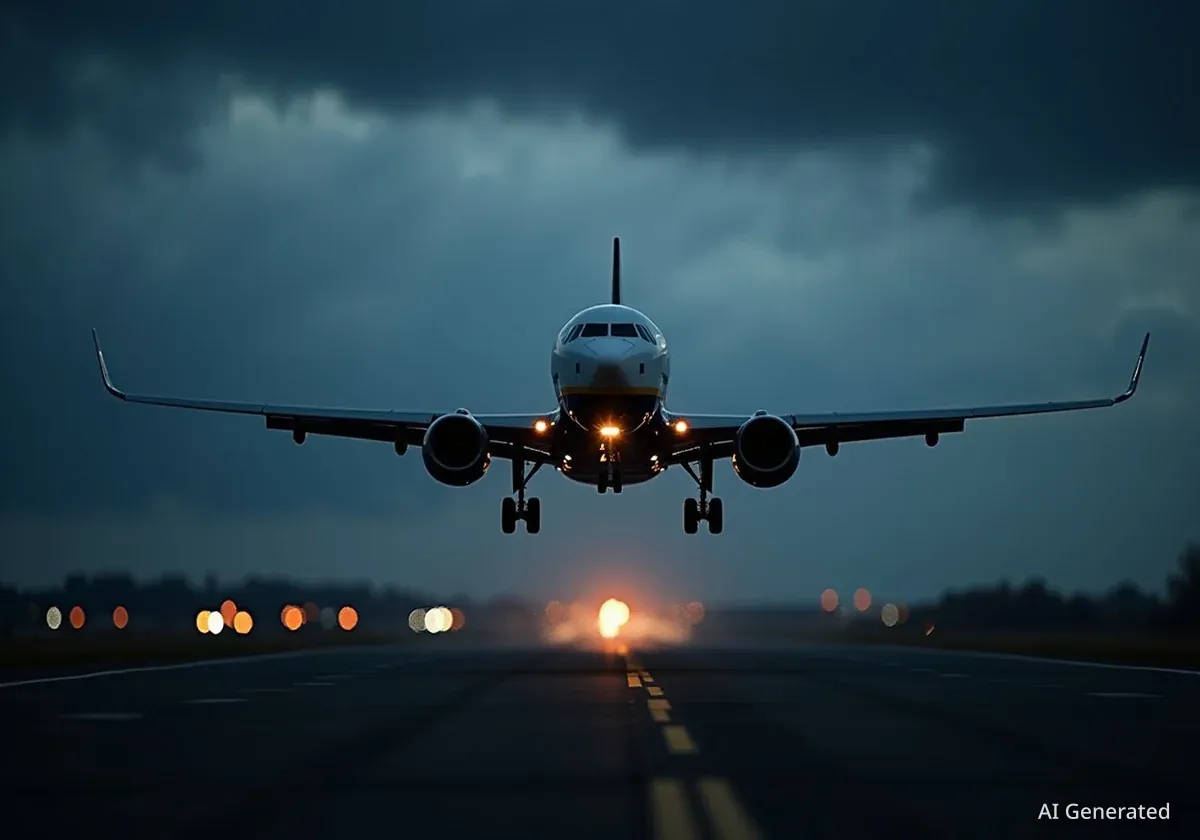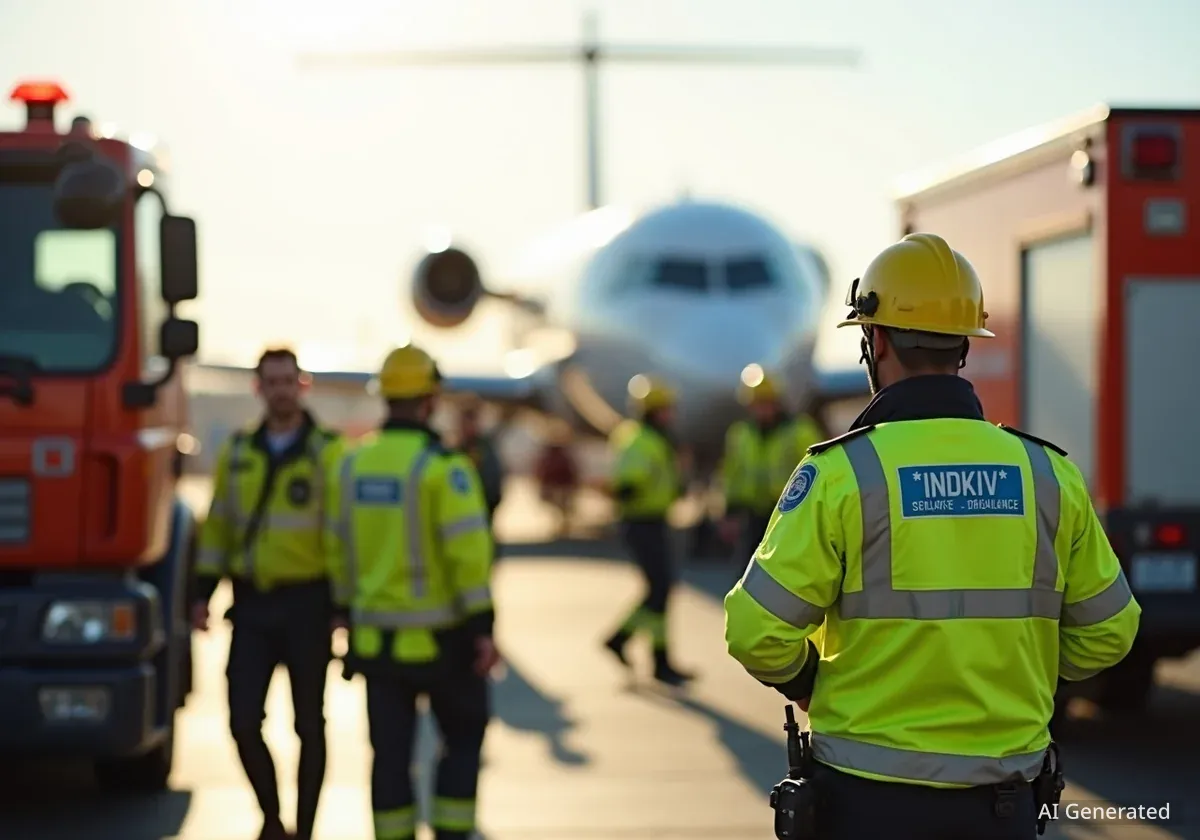A Ryanair flight from Pisa, Italy, to Glasgow, Scotland, was forced to make an emergency landing after its fuel reserves dropped to a critical level. The incident occurred on October 3, with the aircraft landing in Manchester, England, with only minutes of fuel remaining. This event has prompted an investigation by aviation authorities.
Key Takeaways
- Ryanair flight FR6629 declared a 'fuel mayday' during its flight from Pisa to Glasgow.
- The Boeing 737-800 encountered severe weather, including 100 mph winds from Storm Amy.
- Pilots attempted landings at Prestwick and Edinburgh before diverting to Manchester.
- The aircraft landed with approximately 5-6 minutes of fuel, below international regulations.
- Aviation authorities, including the Air Accidents Investigation Branch (AAIB), are investigating the incident.
Flight Encounters Severe Weather and Declares Emergency
The flight, Ryanair FR6629, departed from Pisa, Italy, bound for Glasgow, Scotland, on October 3. During its journey, the Boeing 737-800 aircraft faced challenging weather conditions. Scotland was experiencing the impact of Storm Amy, which brought high winds reaching speeds of up to 100 miles per hour. These severe weather conditions caused significant disruption across Scotland's transportation network, leading to cancellations of various flights, train services, and ferry operations.
As the flight approached Scottish airspace, the cockpit crew realized their fuel levels were critically low. At this point, they issued a 'fuel mayday' alert. This specific distress call signals to air traffic control (ATC) that the aircraft is in a serious situation due to insufficient fuel. The crew also transmitted a 7700 squawk code, which is a universal emergency code that alerts all relevant air traffic units to an aircraft in distress.
Aviation Fuel Regulations
Aviation rules require aircraft to carry a 'final reserve fuel.' This is the absolute minimum fuel needed for an aircraft to remain airborne safely. This reserve must provide at least 30 minutes of flight time. The Ryanair flight landed with significantly less than this requirement.
Multiple Landing Attempts Amid Turbulence
Following the emergency declaration, the pilots initiated attempts to land at Prestwick Airport in Glasgow. However, the extreme turbulence caused by Storm Amy made these attempts unsuccessful. One passenger, Alexander Marchi, described the scene as "dramatic." He noted that the plane was "being buffeted around a lot and jumping" during the descent.
After failing to land at Prestwick, the crew then diverted towards Edinburgh Airport. This attempt also proved unsuccessful due to the persistent severe weather. Marchi recalled the second attempt:
"The second time it was a very bumpy ride and we almost reached the tarmac, but at the last minute we pulled up very sharply."He added, "Everyone was calm until the descent; there were a few worried people on the second descent as we could feel the plane was struggling."
Understanding 'Mayday Fuel'
When pilots anticipate landing with less than the final reserve fuel, they must declare a 'MAYDAY, MAYDAY, MAYDAY FUEL' emergency. This declaration gives the aircraft top priority from air traffic control. Failing to use this specific phraseology can result in ATC not recognizing the severity of the situation immediately. This was a contributing factor in the 1990 Avianca flight crash due to fuel exhaustion, where proper phraseology was not used initially.
Diversion to Manchester and Critical Fuel Levels
With two unsuccessful landing attempts in Scotland, the pilots made the decision to divert the flight to Manchester, England. The aircraft touched down safely at Manchester Airport almost two hours after its initial attempt to land in Prestwick. Upon landing, the seriousness of the situation became clear: the Boeing 737-800 had only about 80 gallons of fuel remaining. This amount is estimated to be sufficient for just 5 to 6 minutes of flight time.
Passenger Alexander Marchi expressed the relief felt by those on board once the flight landed safely. He stated,
"We realized how bad things had been after seeing the images after finally landing at Manchester with almost no fuel. There was a lot of relief. People were wanting to get off and definitely were not up for flying any time soon."The amount of fuel remaining was significantly below the 30-minute final reserve fuel mandated by aviation regulations.
Investigation Underway by Aviation Authorities
Ryanair has confirmed that it reported the incident to the relevant authorities. A spokesperson for the airline stated that they are cooperating fully with an ongoing investigation. They are currently unable to provide further comment due to the active investigation.
The Air Accidents Investigation Branch (AAIB), which is responsible for investigating civil aircraft accidents and serious incidents within the United Kingdom, has launched its own inquiry. A representative from the AAIB confirmed that inspectors have begun gathering evidence and making inquiries into the event. The investigation will aim to determine all factors that contributed to the critical fuel situation, including fuel management procedures and the impact of the severe weather.
Potential Factors in Fuel Exhaustion Incidents
- Improper Fuel Management: This can involve incorrect fuel calculations before takeoff or poor management of fuel during flight.
- Unexpected Weather Conditions: Strong headwind or diversions due to severe weather can increase fuel consumption beyond initial planning.
- Air Traffic Control Delays: Holding patterns or rerouting by ATC can extend flight time and deplete fuel reserves.
- Failure to Declare Emergency: Not using the correct 'mayday fuel' phraseology can prevent an aircraft from receiving priority handling.
Aviation safety relies on strict adherence to fuel regulations and clear communication during emergencies. This incident highlights the importance of these protocols, especially when flights encounter unexpected challenges like severe weather.





